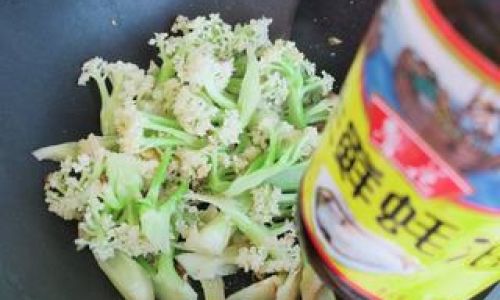Introduction
Stir-fried cauliflower, a dish that marries simplicity with explosive flavor, has become a staple in kitchens worldwide. Originating from Asian culinary traditions, this versatile vegetable transforms into a crispy, tender, and aromatic delight when prepared correctly. Whether you’re a seasoned home cook or a curious novice, mastering the technique of stir-frying cauliflower opens doors to endless culinary creativity. This article delves into the nuances of crafting the perfect stir-fried cauliflower, from selecting the freshest ingredients to executing precise cooking methods. We’ll explore the science behind achieving that coveted balance of texture and taste, along with tips to elevate your dish from ordinary to extraordinary. By the end, you’ll not only know how to stir-fry cauliflower but also understand the cultural and culinary significance of this humble yet mighty vegetable.
The Humble Cauliflower: A Nutritional Powerhouse
Before diving into the cooking process, it’s worth appreciating the star ingredient. Cauliflower, a member of the Brassica oleraceae family, boasts a mild, slightly sweet flavor that acts as a blank canvas for bold seasonings. Beyond its culinary versatility, this cruciferous vegetable is a nutritional powerhouse. Rich in fiber, vitamins C, K, and B6, and antioxidants, cauliflower supports immune health, digestion, and even detoxification. Its low-calorie and high-water content make it an ideal choice for health-conscious eaters, while its ability to absorb flavors ensures it never feels bland.
Selecting the Perfect Cauliflower
The journey to a perfect stir-fry begins at the grocery store or farmers’ market. Look for cauliflower heads with creamy-white, compact florets and vibrant green leaves. Avoid specimens with brown spots, wilting leaves, or a strong sulfurous odor—signs of age or improper storage. Organic cauliflower is preferable for its reduced pesticide exposure, but conventional varieties work fine if thoroughly washed.
Essential Ingredients and Tools
To create a memorable stir-fried cauliflower, gather the following:

- Cauliflower: 1 medium head (about 2 pounds), trimmed and cut into bite-sized florets.
- Aromatics: Garlic (4 cloves, minced), ginger (1-inch piece, grated), and scallions (3 stalks, thinly sliced).
- Aromatic Oil: Toasted sesame oil or peanut oil for high-heat cooking.
- Sauce Base: Soy sauce (2 tbsp), oyster sauce (1 tbsp, optional), rice vinegar (1 tsp), and a pinch of sugar.
- Heat and Texture: Dried red chili flakes or fresh bird’s-eye chilies (to taste), and toasted sesame seeds for garnish.
- Optional Additions: Sliced bell peppers, carrots, or snap peas for color and crunch; protein like diced chicken or tofu for a heartier meal.
Tools of the Trade:
- A carbon-steel wok or large cast-iron skillet (for even heat distribution).
- A sharp chef’s knife and cutting board.
- A spider strainer or slotted spoon for tossing.
- A small bowl for pre-mixing the sauce.
Prepping the Cauliflower: The Devil is in the Details
Proper preparation ensures even cooking and optimal texture. Start by trimming the cauliflower:
- Remove Leaves and Stem: Discard tough outer leaves and trim the thick stem, leaving the florets intact.
- Break into Florets: Use your hands or a knife to separate the cauliflower into uniform pieces. Aim for florets roughly 1.5 inches in diameter—small enough to cook quickly but large enough to retain a satisfying bite.
- Soak and Dry: Soak the florets in cold water for 10 minutes to dislodge dirt or insects. Drain thoroughly and pat dry with a clean kitchen towel. Excess moisture will steam the cauliflower instead of stir-frying it, leading to a soggy texture.
The Stir-Frying Technique: Fire and Precision
Stir-frying is a high-heat, quick-cooking method that sears vegetables, locking in nutrients and flavor. Here’s how to execute it flawlessly:
- Heat the Wok: Place your wok or skillet over high heat. Allow it to smoke lightly—a sign the surface is hot enough to sear. Add 2 tbsp of oil and swirl to coat.
- Aromatics First: Add minced garlic, ginger, and dried chilies (if using). Stir-fry for 15–20 seconds until fragrant but not browned. Burnt garlic will impart bitterness, so timing is crucial.
- Introduce the Cauliflower: Toss the florets into the wok. Use a spatula or spider strainer to toss them continuously, ensuring even exposure to heat. The goal is to char the edges slightly while maintaining a crisp-tender center.
- Add the Sauce: After 3–4 minutes, when the cauliflower begins to soften, pour in the pre-mixed sauce. Toss vigorously to coat each floret. The sauce will caramelize slightly, adding depth.
- Finish with Freshness: Toss in sliced scallions and any additional vegetables or protein. Cook for 1–2 minutes more, until the scallions wilt slightly but retain their vibrancy.
- Garnish and Serve: Transfer to a serving dish. Drizzle with a touch of toasted sesame oil, sprinkle with sesame seeds, and serve immediately.
Achieving the Ideal Texture: Crispy vs. Tender
The beauty of stir-fried cauliflower lies in its textural contrast. To achieve this balance:

- High Heat is Key: Maintain a fierce, consistent heat to sear the cauliflower without steaming it.
- Avoid Overcrowding: Cook in batches if necessary. Overcrowding the wok lowers the temperature, leading to mushy results.
- Test for Doneness: Pierce a floret with a knife. It should meet slight resistance (al dente) rather than collapsing.
Flavor Variations: From Classic to Creative
While the basic recipe is a crowd-pleaser, experimentation is half the fun. Try these twists:
- Spicy Sichuan Style: Add Sichuan peppercorns and doubanjiang (chili bean paste) for a numbing, fiery kick.
- Lemon-Garlic Twist: Finish with a squeeze of lemon juice and a handful of chopped parsley.
- Cheesy Indulgence: Toss with grated Parmesan and a pinch of smoked paprika before serving.
- Vegan Delight: Substitute soy sauce with tamari and add cashews for crunch.
Troubleshooting Common Pitfalls
Even seasoned cooks encounter hiccups. Here’s how to fix them:
- Soggy Cauliflower: Ensure thorough drying before cooking. Use a slotted spoon to remove excess moisture if needed.
- Burnt Aromatics: Prep all ingredients beforehand—stir-frying moves too fast to chop mid-cook.
- Bland Flavor: Amplify the sauce with a splash of fish sauce or a teaspoon of miso paste.
- Uneven Cooking: Cut florets uniformly and toss continuously.
The Science Behind Stir-Frying
Understanding the chemistry of stir-frying elevates your skills. High heat (350–400°F) triggers the Maillard reaction, creating complex flavors through caramelization. The wok’s concave shape concentrates heat, while its metal conducts it efficiently. Oil acts as a heat transfer medium, ensuring even cooking. Meanwhile, the brief cooking time preserves cauliflower’s nutrients, particularly vitamin C, which degrades with prolonged heat exposure.
Pairing Suggestions: Beyond the Bowl
Stir-fried cauliflower shines as a side dish but can anchor a meal. Pair it with:

- Rice: Jasmine, basmati, or brown rice for a comforting base.
- Noodles: Lo mein, chow mein, or zucchini noodles for a low-carb twist.
- Proteins: Grilled shrimp, sliced steak, or crispy tofu.
- Beverages: A crisp lager, jasmine tea, or a lightly sparkling riesling.
Cultural Context: Stir-Frying Through the Ages
Stir-frying traces back to ancient China, where it was developed as a way to cook quickly over wood-fired stoves. The technique preserved ingredients’ freshness during hot summers, aligning with Taoist principles of balance and harmony. Today, it symbolizes efficiency and adaptability—qualities mirrored in the dish’s global popularity.
Health Benefits Revisited: A Dish That Nourishes
Beyond its delicious taste, stir-fried cauliflower offers:
- Anti-Inflammatory Properties: Compounds like indole-3-carbinol combat inflammation.
- Digestive Support: High fiber content aids gut health.
- Weight Management: Low in calories but high in satiety-inducing nutrients.
Conclusion: A Dish Worth Mastering
Stir-fried cauliflower is more than a recipe—it’s a testament to the magic of simplicity. With practice, you’ll learn to wield heat, seasoning, and timing to transform a humble vegetable into a culinary masterpiece. Whether you stick to tradition or innovate wildly, this dish invites creativity and rewards curiosity. So grab your wok, fire up the stove, and let the sizzle begin. Your taste buds—and your guests—will thank you.






0 comments